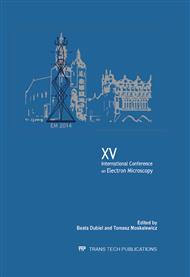p.33
p.41
p.49
p.57
p.65
p.73
p.81
p.87
p.93
Electron Microscopy Investigation of Cast Aluminium Alloy after Laser Feeding with Ceramic Powder
Abstract:
This paper presents the results of an investigation using transmission electron microscopy concerning the structure of AlSi7Cu2 cast aluminium alloy after alloying and remelting with a high power diode laser (HPDL). In particular, the changes in the particle/precipitation type, size and shape were determined, concerning especially the SiC and TiC particles added to the initial material. The aim of this work was also to present the laser treatment technology which will be used for further alloying and remelting with ceramic powders – especially carbides and oxides. The innovatory arrangement of this investigation is based on the mixing of two different powders, which were fed simultaneously to the laser-treated aluminium surface. The overview focuses on the laser power required to achieve good layer hardness to prevent hot work tool steel from losing its work stability and to make the tool surface more resistant to action in external conditions.
Info:
Periodical:
Pages:
65-71
Citation:
Online since:
June 2015
Price:
Сopyright:
© 2015 Trans Tech Publications Ltd. All Rights Reserved
Share:
Citation:


